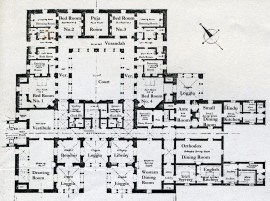Kashmir House, Prithviraj Road, Delhi (1927-29)
Richard Butler
Main entrance (left) and South façade, showing loggias (right), Kashmir House, Prithviraj Road, Delhi (1927-29). Photographed by Penelope Chetwode, c. 1931.
Designed by Walter Sykes George (1881-1962), with significant early input from Edwin Lutyens, Kashmir House is one of Delhi’s most engaging inter-war private residences. The house was designed for a wealthy Hindu banker, Sultan Sing, but his untimely death before the project was completed resulted in it being sold to the maharajah of Patiala, and later to the state of Kashmir.
Sing first asked Lutyens for a design in 1927, but relations between the two were strained and he soon approached George, who maintained a close friendship with Lutyens (his greatest influence). ‘I would like you to build a house for me’, he said, ‘to show what an Indian gentleman’s house should be’. Lutyens eventually backed out of the commission on the grounds that George, having lived continuously in India since 1915, would ‘understand better how an Indian gentleman liked to live’ (George’s words). ‘The banker’, he added, ‘wished to entertain in western fashion, and to have western guests to stay with him, while he, and his family, lived in orthodox Hindu fashion, and he gave dinners in that fashion.’
The building is a fascinating hybrid of Indian and western traditions. Almost all the important rooms are located on the ground floor – only bedrooms are upstairs. The space is laid out around an enclosed courtyard with open loggias to the south. A ground-floor corridor runs the entire length of the house, connecting the ‘western’ and ‘orthodox’ dining rooms, the smaller dining room, the drawing room, some of the bedrooms, and the main west entrance. In an effort to keep different kinds of foods separate – meat especially – the ‘Hindu’ and ‘English’ kitchens are in completely separate wings, though communication is possible between the two dining rooms, when required. There is also a Puja room for daily worship, and segregated entrances allow a more private entrance for the family and their servants, in contrast the more public porch or the trio of loggias, which open onto a garden.
Floor plans (with new labels superimposed), Kashmir House, Delhi. Originally published in Walter George, ‘The Architecture of Walter George’, Design (Bombay) (Sept., 1960), p. 21.
George used small windows and thick walls to counter the effects of the hot climate. The use of a courtyard and south-facing loggias meant that all the ground floor bedrooms, including the principal ones, are shaded and lit indirectly. Furthermore, the upstairs windows are sunken and mostly hidden from view from the garden and entrance driveway, which would have ensured privacy for Sing’s family, and the upstairs was likely reserved for family quarters. Curiously, George said he was aware of what Frank Lloyd Wright was doing at this time in America, but he could not copy them in India as both English and Hindu uses ‘require privacy, and there is little privacy in Wright’s houses.’
Kashmir House still exists, though much altered. With Sing’s death went the opportunity to use the building’s plan as originally intended.
..
More information on the architecture of Walter George can be found in Richard Butler, ‘The Anglo-Indian architect Walter Sykes George (1881-1962): a Modernist follower of Lutyens’, Architectural History, vol. 55 (2012), pp. 237-68.
All images reproduced courtesy of Professor Gavin Stamp (original Chetwode photographs now kept by RIBA, London).



